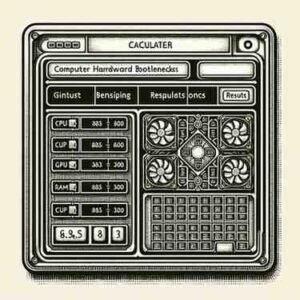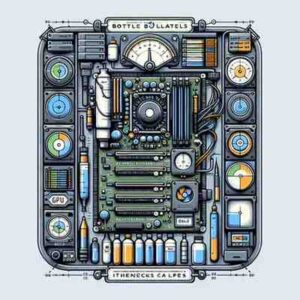In the realm of high-performance computing and gaming, each millisecond matters. Whether you’re an avid gamer, an IT professional, or a technology enthusiast, making sure your system is operating at peak performance is essential. This is where bottleneck calculator come into play. These powerful tools help you discover which elements in your system may be holding them back. It allows you to make smarter upgrade decisions and optimize your configuration to maximize efficiency.

Contents
What is a Bottleneck Calculator?
A computing bottleneck is the piece of equipment in your computer system that impedes overall performance. Consider it the weakest component of a chain. It is most often the CPU (Central Processing Unit) as well as the GPU (Graphics Processing Unit). However, other components, such as storage and RAM, can have their own bottlenecks. Finding the bottlenecks that are causing your system to slow down is critical to improving its performance.
A bottleneck calculator is a diagnostic tool that assesses the performance of a computer’s hardware components, particularly the CPU (Central Processing Unit) and GPU (Graphics Processing Unit). The tool identifies which component hinders the overall effectiveness of the machine, called “the bottleneck.” The tool can identify bottlenecks, and users can make informed decisions regarding hardware upgrades to improve their computer experience.

Below is a step-by-step explanation of how it usually works:
- Input Specifications: Users enter the particulars about their CPU, RAM, GPU, and sometimes other components into the calculator. This includes information about the core count or clock frequency. It also includes architecture and performance metrics.
- Performance Analysis The calculator evaluates these specifications against a database of performance benchmarks. It analyzes how every component is performing in relation to its peers.
- Discover Bottlenecks The software determines if either the GPU or CPU is causing a bottleneck by analyzing the components that are operating at a lower level than the potential of their capabilities due to restrictions set by the counterpart component. To put it another way, the software identifies the CPU as a bottleneck if its processing speed fails to match that of the GPU.
- The calculator offers recommendations. Based on an analysis and results, the tool provides recommendations that suggest modifying one or more components to potentially remove the bottleneck. It could suggest a stronger CPU, a better GPU, or even more RAM, in line with the identified issue.
This calculator, with the help of a bottleneck calculator, will help you make the right choices regarding hardware upgrades that enhance your computer’s performance.
There are several reasons why you need a bottleneck calculator.
Bottleneck calculator are a must-have tool for anyone seeking to enhance the performance of their PC. They let you know which component is causing the slowdown, allowing you to determine the most appropriate upgrades. This is particularly important because it relates to players, IT professionals, and tech lovers who depend on them for high-performance applications.
Gamers
For gaming enthusiasts, a smooth and lag-free experience is crucial. A bottleneck calculator can enable you to figure out if your GPU is keeping pace with the CPU or how much. This allows you to make the most of your gaming hardware and provide a fluid gaming experience.
IT Professionals
IT specialists frequently have multiple IT systems and must ensure that each system is running efficiently. The Bottleneck Calculator can give you valuable insights into the components that require updating to reduce time and resources.
Tech Enthusiasts
For tech lovers, optimizing the speed of your PC can be an exciting and challenging task. Bottleneck calculator carefully analyze your system’s performance to help you optimize each part for best results.
Here is a step-by-step guide that will help you identify bottlenecks in your system without the need for automated software:
Step 1: Gather the System Specifications
Make a note of every detail related to your hardware configuration, for instance:
- The CPU is characterized by its model, core count, clock speed, and architecture.
- GPU model, VRAM, and performance benchmarks.
- Consider the quantity, speed, and type of RAM, such as DDR4.
Step 2: Research Performance Benchmarks
You can find benchmarks and performance tests for your GPU and CPU. Websites like PassMark, UserBenchmark, and Tom’s Hardware provide detailed performance details for a variety of components.
Step 3: Compare CPU and GPU Performance
Examine the performance ratings of your CPU and GPU. Here’s how you can do it:
- The CPU’s performance. Look up the single-threaded and multi-threaded performance ratings.
- GPU Performance Examine the general performance score along with specific benchmarks that are relevant to the type of work you’re doing (e.g., gaming, video editing).
Step 4: Identify potential bottlenecks.
Assess if there’s an important inconsistency between the CPU and GPU’s performance. There are some general guidelines:
- CPU bottleneck If your CPU’s performance scores are significantly lower than the GPU’s, it may be inhibiting performance.
- GPU Bottleneck: If your GPU’s performance is lower than your CPU’s, then the GPU may be a bottleneck.
Step 5: Examine real-world performance
Run performance-intensive applications or games and monitor the CPU and GPU usage using tools like Task Manager (Windows), Activity Monitor (Mac), or third-party software like MSI Afterburner. Here’s what to look for:
- High CPU usage If the CPU’s capacity is constant or near 100% and the GPU usage is lower, the CPU is likely the bottleneck.
- High GPU Usage: If the GPU’s utilization has been constant or close to 100% and the CPU is using less power, then the GPU could be the main bottleneck.
Step 6: Take a look at RAM and storage.
Be sure to have the right resources for your projects. An insufficient amount of RAM will cause the CPU and GPU to wait to receive data, which creates unneeded bottlenecks. Similar to slow storage (HDD versus SSD), it can significantly impact the overall performance of your system.
Step 7: Make informed decisions.
Depending on your assessment, Determine the system’s upgrade needs based on your analysis. Here are some tips:
- Update CPU If the processor is the biggest bottleneck in your system, look into having a machine with a higher number of cores, higher speeds for clocks, or even a more modern architecture.
- Upgrade GPU If your GPU is the culprit, look into a faster graphic card and one that is able to perform higher benchmarks.
- Improve RAM If you think RAM might be the issue, consider adding more memory or upgrading to faster RAM.
Example Calculation
Say you have an Intel Core I5-8400 CPU and an NVIDIA GTX 1080 GPU. The following benchmark scores:
- CPU (i5-8400): Single-threaded score: 2,200. Multi-threaded score: 11,000
- GPU (GTX 1080): Performance score: 13,000
If your CPU usage during gaming is between 90 and 100% and your GPU usage is between 60% and 70%, it indicates a CPU issue. An upgrade to a higher-end CPU, like the Intel Core i7-9700K CPU, might balance the performance.

The benefits of using a bottleneck calculator
Bottleneck calculator boast a range of advantages, making them essential solutions for improving the performance of your computer.
Cost-Effective Upgrades
If you can identify the particular component that is holding you back, bottleneck calculator will help you stay clear of unneeded upgrades. That means you’ll be able to allocate your budget to the components that will have the most significant impact on your system’s performance.
Enhanced Performance
By leveraging the data from a bottleneck calculation, you can achieve optimal performance for your system, ensuring that each component interacts seamlessly. The result is a faster and more efficient computing experience in gaming, working, or just browsing the web.
Future-Proofing
These calculator can help you design your future. You can determine which parts are most likely to become bottlenecks as technology progresses. You can make informed decisions about any necessary upgrades. Your system will run efficiently for many years to come.
Strategies for Using Bottleneck calculator
To use your bottleneck calculator to the fullest, follow these guidelines:
Don’t be sloppy with your input.
Check for accuracy, as well as detailed information about your system. This will ensure the most efficient results and guidelines.
Consider multiple calculator .
Utilizing more than one bottleneck calculator gives a complete analysis. Different calculator could have distinct algorithmic features and algorithms that provide new insights.
Stay Current
Maintain your system’s specifications, as well as keep the database for your bottleneck calculator updated. Modern components and techniques are ever-changing, and keeping current will mean that your system is running with the latest advice.
A variety of bottlenecks
Different kinds of bottlenecks or issues may hinder the performance of computers, all of which require several solutions.
- CPU Bottleneck: This occurs when the CPU’s power is not enough to maintain the speed of the GPU. It’s commonplace in games when the CPU is struggling to manage the game’s complexities while the GPU is waiting for data.
- GPU Bottleneck Is it a sign that the GPU is the main reason for being unable to render graphics at a speed that keeps pace with the CPU’s information processing?
- RAM Bottleneck Lack of memory prevents the CPU and GPU from operating to their full potential as they wait for information to load onto slower storage systems like HDDs and SSDs.
Conclusion
Anyone trying to increase their computer’s performance can use bottleneck calculator as a valuable tool. If you can identify and fix bottlenecks and limiting factors, you’ll be able to make sure that your system runs smoothly and efficiently, whether you’re playing, creating videos, or just browsing the internet. Through careful analysis and strategically planned modifications, you’ll enjoy the perfect balance and a high-performance user experience.
Bottleneck calculator are powerful solutions that could significantly improve your PC’s performance. By pinpointing the parts that block your computer’s performance, these calculator enable you to make informed decisions when it comes to upgrading and optimizing. Be it a computer gamer, IT professional, or tech fanatic, identifying and solving bottlenecks will help you get the most out of your equipment.
Are you prepared to improve your computer’s performance? Take advantage of a bottleneck tool today and discover your hardware’s maximum potential. For further tips and guides, take a look at our site and join our group filled with tech enthusiasts. Let’s work together to optimize!